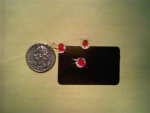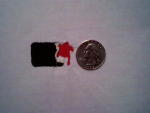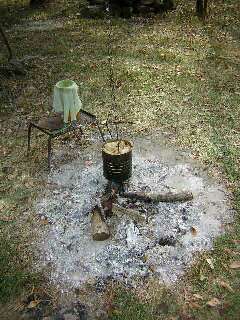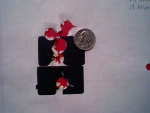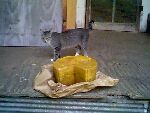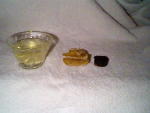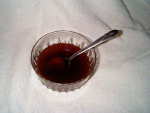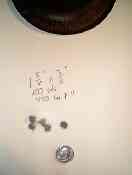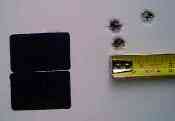|
There's only one thing wrong with store-bought bullet lube—it's store-bought. Anything you can make yourself is better because . . . well, because. If I have to explain that fact to you, click here. I've been making my own bullet lube for my blackpowder rifles and pistols since I read somewhere that natural, animal fat based bullet and patch lubes produced much less fouling and required much less bore cleaning. I tried it, and it worked. I could literally shoot both my .50 caliber Lyman Great Plains Hunter and my .32 caliber Traditions Crockett Rifle all afternoon without cleaning the bores.
My .32 caliber Traditions Crockett Rifle shoots patched round balls only. I put 100 dry patches in a zip sandwich bag and pour about 1/2 fluid oz of melted, 100% hog lard in the bag with the patches. Knead the bag for a couple of minutes, and all of the patches will fully absorb the lard/lube. As you can see from the photos on the right, the little rifle shoots like a dream using round balls and lard-lubed patches. Groups like those are common from my little .32 muzzleloader. Tell the truth—will your high-dollar .22 rimfire shoot a 3 shot, 1-hole group at 25 yards with iron sights?
At the time I had no beeswax, but I did have a tube of Hodgdon Alox lube for use in my lubrisizer on hard-cast pistol and rifle bullets. Alox bullet lube consists of 50% beeswax and 50% Alox 2138F liquid lube, which is made from calcium and mineral spirits, a petroleum product. Now, I realized, I needed to carefully measure every ingredient of my lube mixture for repeatability if it was ok and for further refinement if it was not ok. I had on hand some empty medicine bottles that looked like they would make perfect lube containers—wide-mouthed for ease of digging inside with my finger and not too big and not too small, holding about 5 fluid ozs. Perfect. So I arbitrarily decided on exactly 4 fluid ozs of lard, or, exactly 1/2 cup of lard. I cut about 1/2 inch off the end of the tube of Alox bullet lube, put it in my powder scale, and added Alox shavings until it weighed exactly 100 grs, deciding upon that weight via an educated guess. In other words, that amount looked about right and 100 was easy to remember. My final mixture would then have only 50 grs at the most of a petroleum product, the "mineral spirits." That's about 1/2 tsp or about 2%. In a glass container, I then melted a glob of lard in my microwave—2 minutes on high. I then measured exactly 4 fluid ozs of that melted lard into another glass container. To that container I then added the 100 gr chunk of Alox bullet lube and stirred the mixture until the chunk melted, having to microwave again for 1 minute.
I soon headed for my front yard shooting range. As you can see from the group on the right, my lard/Alox lube mixture worked perfectly. Shot #2 loaded as easily as shot #50. I was a happy fellow. I even christened my concoction Junior Lube and had visions of selling it by the case and getting filthy rich. But a couple of months passed and cool weather turned warm, then hot. One bright, hot day I got out my .50 caliber and its shooting accouterments—including the prized and valuable bottle of Junior Lube—and headed outside to pop some caps and make some smoke and noise and send some 320 gr chunks of lead downrange. Lo and behold after being outside a few minutes, the Junior Lube liquified. Back to the drawing board. . . . I needed to add beeswax to the mixture—no paraffin wax in my lube! By surfing the Internet I found beeswax for $3.50 a lb and for $8.00 a lb. Both prices sounded high to me. A few days later while surfing down a country road in the Bluesmobile and headed for a fishing hole, I saw a sign that read HONEY and that had a crude arrow pointing to a narrow road.
 After following the road for a mile or so, I found a house with beehives in various stages of disrepair out front. I stopped and got out and hollered—in the country it ain't polite to blow your horn at somebody's house. Out came an elderly gentleman. I said I was after beeswax, and he said he had some for sale. Then he started asking about my momma and daddy—in the country you got to know who's hollering at your house.
Turned out the old fellow was my daddy's first cousin! While talking about kinfolks, mostly my daddy and the old man's and my daddy's common uncle, "Limber" Jim Bradford, we walked around his house to a little building containing his honey-processing equipment. He pulled the chunk of beeswax you see in the photo on the right out of a bucket-looking container beneath a vat-like machine that melts the honeycomb. I saw no active beehives around so I asked him about the locations of his hives. He informed me that he had about 100 hives scattered for about 50 miles across the Mississippi Delta, Louisiana side. To me, that beeswax suddenly became special because I'm nuts about anything to do with the Mississippi Delta. Still talking about kinfolks, he went looking for an axe and soon returned, wiping dirt from the blade. "How much o' that chunk o' wax you want?" he asked me. "Gimme about $5 worth," I answered. "Hell, if you want that much," he said, "you can have the whole damn chunk." It weighed exactly 10 lbs. In the full size version of the above photo, you can see black specks of impurities, mostly scorched honey. They don't matter because when the wax melts, they settle to the bottom. Meanwhile, back at the drawing board. . . . I decided that I:
Based on the weight of water, a fluid oz (slightly more or slightly less because it was hard to pour into the pan of my scale) weighs in the neighborhood of 375 grs. I decided to use 400 grs of solid beeswax because 400 was easy to remember.
I put those ingredients into a slightly larger microwave-safe glass bowl and heated it in the microwave on "High" for 2 minutes. Then I stirred it with the spoon you see, helping the beeswax to completely melt. Then I waited maybe 30 seconds for the impurities that were in the beeswax to settle to the bottom of the mixture. Then I slowly and carefully poured the mixture through a small funnel and into a medicine bottle, leaving the dregs/impurities in the bottom of the glass bowl. After several minutes of cooling, there before my eyes sat a bottle of new Junior Lube. When it had solidified sufficiently (and turned tan), I took it outside and set it in the shade on my front porch. The thermometer on the porch read 95° F. I left the bottle there and went back inside to the air conditioner. An hour later, I went out and checked the lube. It was solid. I stuck my finger in it and dug around. The consistency was perfect for finger-applying to a bullet. Junior Lube works great for hot and cold weather lubrication on my .50 caliber 320 gr Lee R.E.A.L. bullet. It also works great on black powder cartridge bullets.
Using your finger, just daub Junior Lube in the bullet's lube grooves and seat like normal. In cold weather, warm the bottle a little before using. I have fired Pyrodex-propelled bullets lubed with Junior Lube through my 45-70 all afternoon without once cleaning the barrel. The fouling behind shot #1 looks exactly like the fouling behind shot #50. That's in high humidity Louisiana. Results in Arizona might be different. I also use Junior Lube as outside neck lube for 45-70 and 30-30 cases neck-sized in Lee Loaders. Using my finger, I wipe a very thin smear around the case neck. I wouldn't use it for full-length sizing, but it works fine for neck sizing.
No additives!! If you don't want to make your own Junior Lube or BPCR cookie mix you can buy them from me. One 32 oz bag of cookie mix will make several hundred cookies. Cookie mix is made to order so allow extra delivery time. Note on the table below that you can buy 100% pure lard for making your own lube or cookie mix at home. About the only way to get pure lard is to render it yourself or buy it here. Store-bought lard contains preservatives including citric acid! There's nothing in this lard but lard. Note! Even pure lard contains a trace of salt. It's an animal product. Use this pure lard for:
Click the proper PayPal icon in the tables below, and you can securely pay with a credit card. Or send a check or money order to:
Kim Doughty-Ganey
I AM CURRENTLY COMPLETELY OUT OF JUNIOR LUBE!
For the 32 oz sizes of lube or lard, store box and all in a refrigerator or freezer and dip out with a spoon as needed.
|
